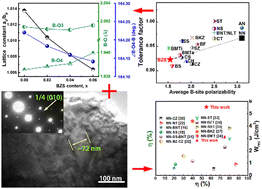Ultrahigh phase-transition electric field and giant energy density in NaNbO3–Bi(Zn0.5Sn0.5)O3 lead-free antiferroelectric ceramics
Abstract
Antiferroelectric (AFE) materials demonstrate great potential for dielectric energy-storage applications owing to the field-induced AFE–ferroelectric phase transition. The adjustment of the driving electric field for the phase transition (EAF) is critical for achieving high energy-storage properties in AFEs. In this work, a complex perovskite Bi(Zr0.5Sn0.5)O3 (BZS) with simultaneously small tolerance factor and B-site ion polarizability was introduced into NaNbO3 (NN) to form (1–x)NN–xBZS solid solutions. The results of X-ray diffraction, transmission electron microscopy and Raman spectra indicate that the room-temperature AFE orthorhombic P phase of NN can be effectively stabilized by increasing the BZS content, which is closely related to the reduced off-centering displacements of B-site cations and enhanced antiferrodistortive degree. This process is also accompanied by a reduced AFE domain size owing to the disrupted long-range AFE order. As a result, a significantly enhanced EAF of ≥45 kV mm−1 was realized at x = 0.06, strikingly leading to a giant recoverable energy-storage density of ∼5.5 J cm−3. This work makes a breakthrough progress in energy-storage performances of NN-based AFE P-phase ceramics by controlling the EAF, which might provide a new strategy for developing AFE energy-storage materials.

- This article is part of the themed collection: 2023 Journal of Materials Chemistry C HOT Papers


 Please wait while we load your content...
Please wait while we load your content...